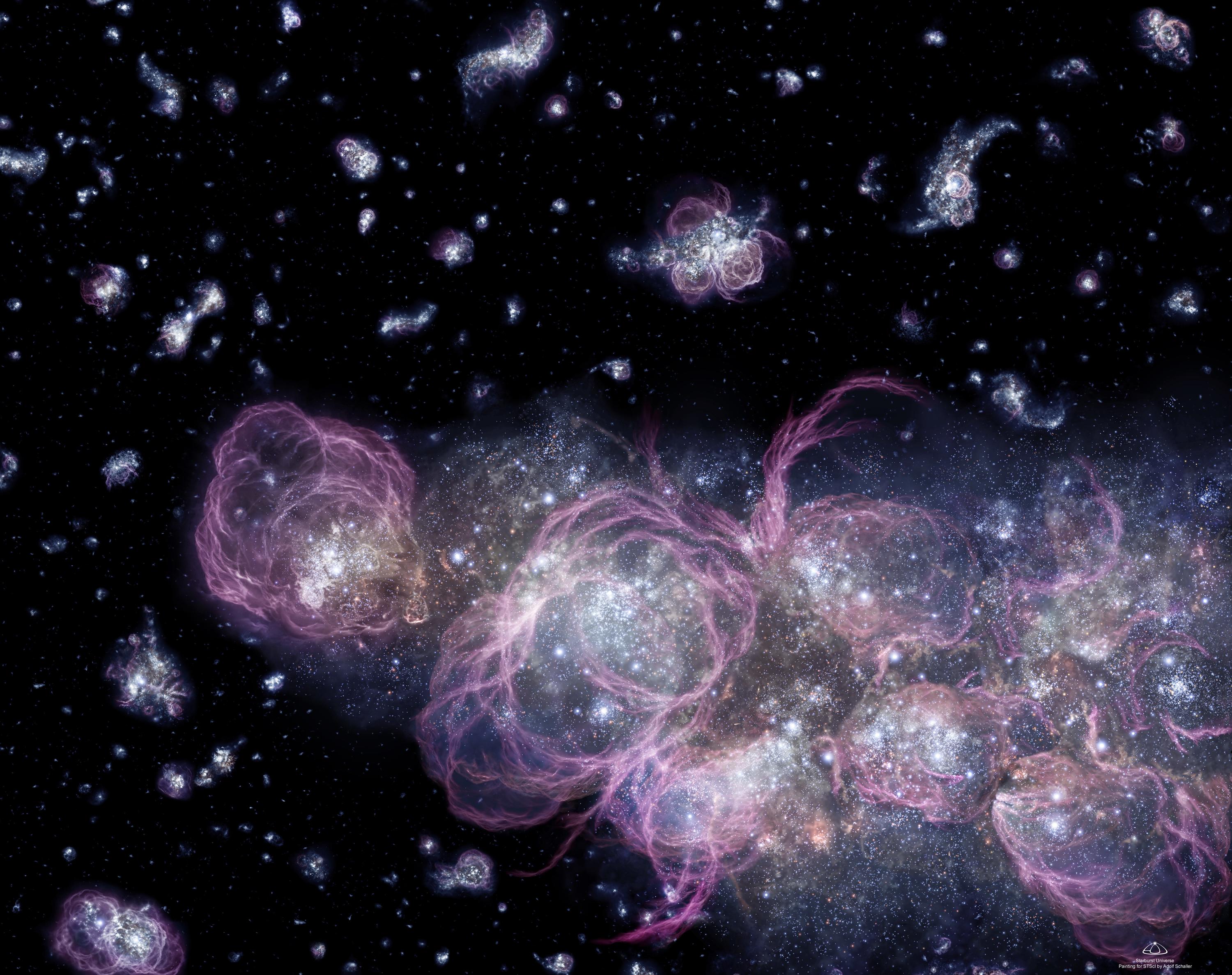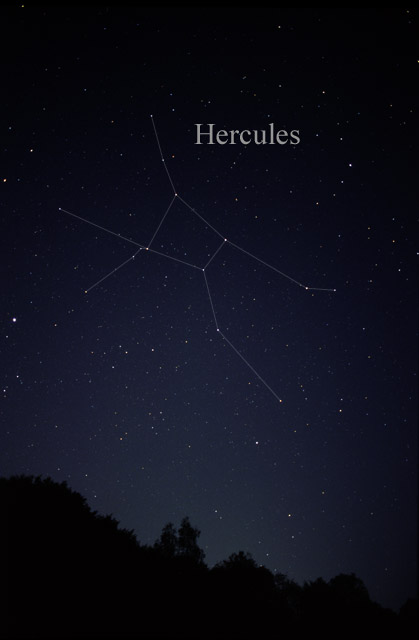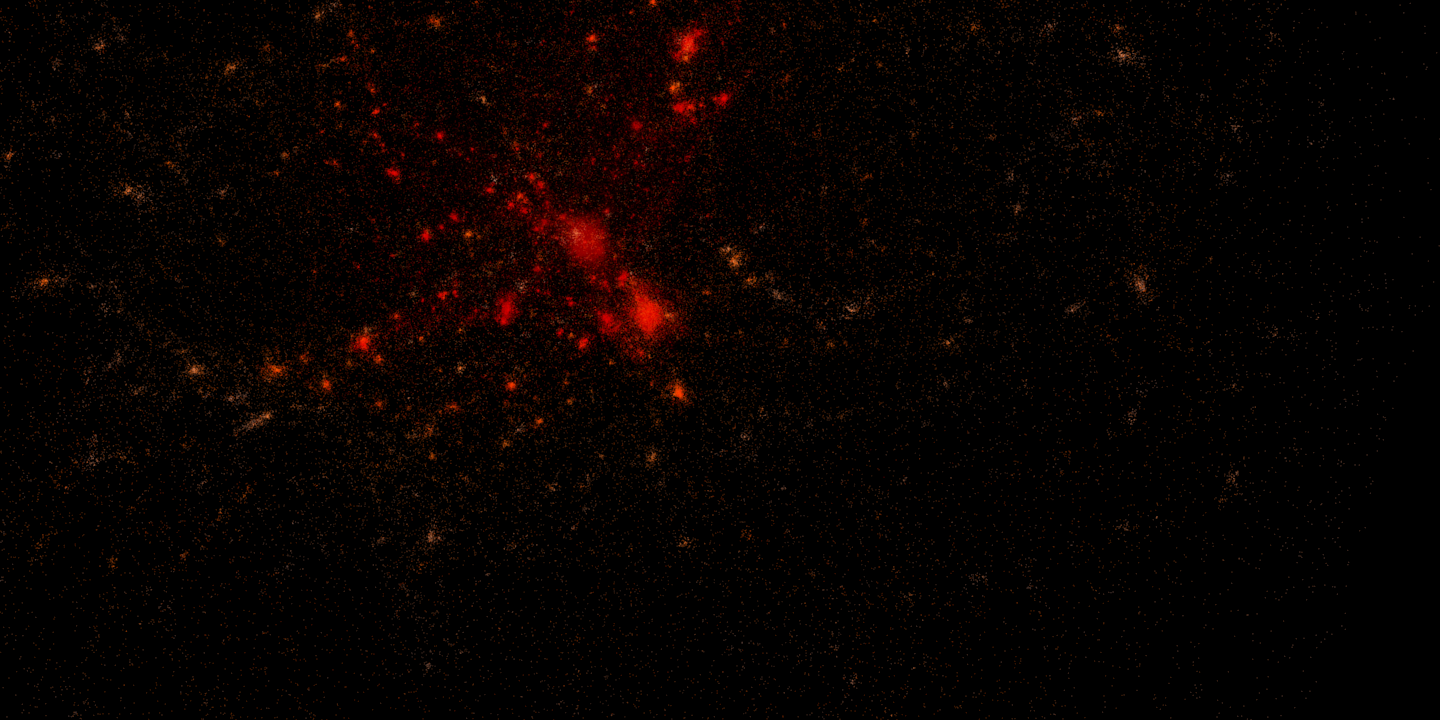|
Galaxy Group
A galaxy group or group of galaxies (GrG) is an aggregation of galaxies comprising about 50 or fewer gravitationally bound members, each at least as luminous as the Milky Way (about 1010 times the luminosity of the Sun); collections of galaxies larger than groups that are first-order clustering are called galaxy clusters. The groups and clusters of galaxies can themselves be clustered, into superclusters of galaxies. The Milky Way galaxy is part of a group of galaxies called the Local Group. Characteristics Groups of galaxies are the smallest aggregates of galaxies. They typically contain no more than 50 galaxies in a diameter of 1 to 2 megaparsecs (Mpc).see 1022 m for distance comparisons Their mass is approximately 1013 solar masses. The spread of velocities for the individual galaxies is about 150 km/s. However, this definition should be used as a guide only, as larger and more massive galaxy systems are sometimes classified as galaxy groups. Groups are the most c ... [...More Info...] [...Related Items...] OR: [Wikipedia] [Google] [Baidu] |
Hubble Views Bizarre Cosmic Quartet HCG 16
The Hubble Space Telescope (often referred to as HST or Hubble) is a space telescope that was launched into low Earth orbit in 1990 and remains in operation. It was not the first space telescope, but it is one of the largest and most versatile, renowned both as a vital research tool and as a public relations boon for astronomy. The Hubble telescope is named after astronomer Edwin Hubble and is one of NASA's Great Observatories. The Space Telescope Science Institute (STScI) selects Hubble's targets and processes the resulting data, while the Goddard Space Flight Center (GSFC) controls the spacecraft. Hubble features a mirror, and its five main instruments observe in the ultraviolet, visible, and near-infrared regions of the electromagnetic spectrum. Hubble's orbit outside the distortion of Earth's atmosphere allows it to capture extremely high-resolution images with substantially lower background light than ground-based telescopes. It has recorded some of the most detai ... [...More Info...] [...Related Items...] OR: [Wikipedia] [Google] [Baidu] |
Hickson Compact Group
A Hickson Compact Group (abbreviation: HCG) is a collection of galaxies designated as published by Paul Hickson in 1982. The most famous group on Hickson's list of 100 objects is HCG 92, Stephan's Quintet. Hickson Compact Groups According to Hickson: “Most compact groups contain a high fraction of galaxies having morphological or kinematical peculiarities, nuclear radio and infrared emission, and starburst or active galactic nuclei (AGN) activity. They contain large quantities of diffuse gas and are dynamically dominated by dark matter. They most likely form as subsystems within looser associations and evolve by gravitational processes. Strong galaxy interactions result and merging is expected to lead to the ultimate demise of the group. Compact groups are surprisingly numerous, and may play a significant role in galaxy evolution.” List Gallery Image:A fossil in the making.jpg, NGC 201 is a barred spiral galaxy similar to the Milky Way, a member of HCG 7 Image:A members ... [...More Info...] [...Related Items...] OR: [Wikipedia] [Google] [Baidu] |
Protogalaxy
In physical cosmology, a protogalaxy, which could also be called a "primeval galaxy", is a cloud of gas which is forming into a galaxy. It is believed that the rate of star formation during this period of galactic evolution will determine whether a galaxy is a spiral or elliptical galaxy; a slower star formation tends to produce a spiral galaxy. The smaller clumps of gas in a protogalaxy form into stars. The term "protogalaxy" itself is generally accepted to mean "Progenitors of the present day (normal) galaxies, in the early stages of formation." However, the "early stages of formation" is not a clearly defined phrase. It could be defined as: "The first major burst of star formation in a progenitor of a present day elliptical galaxy"; "The peak merging epoch of dark halos of the fragments which assemble to produce an average galaxy today"; "A still gaseous body before any star formation has taken place."; or " an over-dense region of dark matter in the very early universe, dest ... [...More Info...] [...Related Items...] OR: [Wikipedia] [Google] [Baidu] |
Hercules (constellation)
Hercules is a constellation named after Hercules, the Roman mythological hero adapted from the Greek hero Heracles. Hercules was one of the 48 constellations listed by the second-century astronomer Ptolemy, and it remains one of the 88 modern constellations today. It is the fifth-largest of the modern constellations and is the largest of the 50 which have no stars brighter than apparent magnitude +2.5. Characteristics Hercules is bordered by Draco to the north; Boötes, Corona Borealis, and Serpens Caput to the east; Ophiuchus to the south; Aquila to the southwest; and Sagitta, Vulpecula, and Lyra to the west. Covering 1225.1 square degrees and 2.970% of the night sky, it ranks fifth among the 88 constellations in size. The three-letter abbreviation for the constellation, as adopted by the International Astronomical Union in 1922, is 'Her'. The official constellation boundaries, as set by Eugène Delporte in 1930, are defined by a polygon of 32 segments (''illustrate ... [...More Info...] [...Related Items...] OR: [Wikipedia] [Google] [Baidu] |
Constellation
A constellation is an area on the celestial sphere in which a group of visible stars forms a perceived pattern or outline, typically representing an animal, mythological subject, or inanimate object. The origins of the earliest constellations likely go back to prehistory. People used them to relate stories of their beliefs, experiences, creation, or mythology. Different cultures and countries adopted their own constellations, some of which lasted into the early 20th century before today's constellations were internationally recognized. The recognition of constellations has changed significantly over time. Many changed in size or shape. Some became popular, only to drop into obscurity. Some were limited to a single culture or nation. The 48 traditional Western constellations are Greek. They are given in Aratus' work ''Phenomena'' and Ptolemy's '' Almagest'', though their origin probably predates these works by several centuries. Constellations in the far southern sky were ad ... [...More Info...] [...Related Items...] OR: [Wikipedia] [Google] [Baidu] |
Light-year
A light-year, alternatively spelled light year, is a large unit of length used to express astronomical distance, astronomical distances and is equivalent to about 9.46 Orders of magnitude (numbers)#1012, trillion kilometers (), or 5.88 trillion miles ().One trillion here is long and short scales, taken to be 1012 (one million million, or billion in long scale). As defined by the International Astronomical Union (IAU), a light-year is the distance that Speed of light, light travels in a vacuum in one Julian year (astronomy), Julian year (365.25 days). Because it includes the time-measurement word "year", the term ''light-year'' is sometimes misinterpreted as a unit of time. The ''light-year'' is most often used when expressing distances to stars and other distances on a Galaxy, galactic scale, especially in public understanding of science, non-specialist contexts and popular science publications. The unit most commonly used in professional astronomy is the parsec (symbol ... [...More Info...] [...Related Items...] OR: [Wikipedia] [Google] [Baidu] |
Elliptical Galaxy
An elliptical galaxy is a type of galaxy with an approximately ellipsoidal shape and a smooth, nearly featureless image. They are one of the four main classes of galaxy described by Edwin Hubble in his Hubble sequence and 1936 work ''The Realm of the Nebulae'', with their intermediate scale disks, a subset of the "early-type" galaxy population. Most elliptical galaxies are composed of older, low-mass stars, with a sparse interstellar medium and minimal star formation activity, and they tend to be surrounded by large numbers of globular clusters. Elliptical galaxies are believed to make up approximately 10–15% of galaxies in the Virgo Supercluster, and they are not the dominant type of galaxy in the universe overall. They are preferentially found close to the centers of galaxy clusters. Elliptical galaxies range in size from dwarf ellipticals with tens of millions of stars, to supergiants of over one hundred trillion stars that dominate their galaxy clusters. Originally, ... [...More Info...] [...Related Items...] OR: [Wikipedia] [Google] [Baidu] |
NGC 6482
NGC commonly refers to: * New General Catalogue of Nebulae and Clusters of Stars, a catalogue of deep sky objects in astronomy NGC may also refer to: Companies * NGC Corporation, name of US electric company Dynegy, Inc. from 1995 to 1998 * National Gas Company of Trinidad and Tobago, state-owned natural gas company in Trinidad and Tobago * National Grid plc, a former name of National Grid Electricity Transmission plc, the operator of the British electricity transmission system * Northrop Grumman Corporation, aerospace and defense conglomerate formed from the merger of Northrop Corporation and Grumman Corporation in 1994 * Numismatic Guaranty Corporation, coin certification company in the United States Other uses * National Gallery of Canada, art gallery founded in 1880 in Ottawa, Canada * National Geographic, documentary and reality television channel established in the United States in 2001 formerly called National Geographic Channel * Native Girls Code, US non-profit organ ... [...More Info...] [...Related Items...] OR: [Wikipedia] [Google] [Baidu] |
N-body Simulation
In physics and astronomy, an ''N''-body simulation is a simulation of a dynamical system of particles, usually under the influence of physical forces, such as gravity (see n-body problem, ''n''-body problem for other applications). ''N''-body simulations are widely used tools in astrophysics, from investigating the dynamics of few-body systems like the Earth-Moon-Sun system to understanding the evolution of the large-scale structure of the universe. In physical cosmology, ''N''-body simulations are used to study processes of non-linear structure formation such as galaxy filaments and galaxy halos from the influence of dark matter. Direct ''N''-body simulations are used to study the dynamical evolution of star clusters. Nature of the particles The 'particles' treated by the simulation may or may not correspond to physical objects which are particulate in nature. For example, an N-body simulation of a star cluster might have a particle per star, so each particle has some physic ... [...More Info...] [...Related Items...] OR: [Wikipedia] [Google] [Baidu] |
Dwarf Galaxies
A dwarf galaxy is a small galaxy composed of about 1000 up to several billion stars, as compared to the Milky Way's 200–400 billion stars. The Large Magellanic Cloud, which closely orbits the Milky Way and contains over 30 billion stars, is sometimes classified as a dwarf galaxy; others consider it a full-fledged galaxy. Dwarf galaxies' formation and activity are thought to be heavily influenced by interactions with larger galaxies. Astronomers identify numerous types of dwarf galaxies, based on their shape and composition. Formation One theory states that most galaxies, including dwarf galaxies, form in association with dark matter, or from gas that contains metals. However, NASA's Galaxy Evolution Explorer space probe identified new dwarf galaxies forming out of gases with low metallicity. These galaxies were located in the Leo Ring, a cloud of hydrogen and helium around two massive galaxies in the constellation Leo. Because of their small size, dwarf galaxies have bee ... [...More Info...] [...Related Items...] OR: [Wikipedia] [Google] [Baidu] |
Intracluster Medium
In astronomy, the intracluster medium (ICM) is the superheated plasma that permeates a galaxy cluster. The gas consists mainly of ionized hydrogen and helium and accounts for most of the baryonic material in galaxy clusters. The ICM is heated to temperatures on the order of 10 to 100 megakelvins, emitting strong X-ray radiation. Composition The ICM is composed primarily of ordinary baryons, mainly ionised hydrogen and helium. This plasma is enriched with heavier elements, including iron. The average amount of heavier elements relative to hydrogen, known as metallicity in astronomy, ranges from a third to a half of the value in the sun. Studying the chemical composition of the ICMs as a function of radius has shown that cores of the galaxy clusters are more metal rich than at larger radii. In some clusters (e.g. the Centaurus cluster) the metallicity of the gas can rise to above that of the sun. Due to the gravitational field of clusters, metal-enriched gas ejected from supernova ... [...More Info...] [...Related Items...] OR: [Wikipedia] [Google] [Baidu] |
Dynamical Friction
In astrophysics, dynamical friction or Chandrasekhar friction, sometimes called ''gravitational drag'', is loss of momentum and kinetic energy of moving bodies through gravitational interactions with surrounding matter in space. It was first discussed in detail by Subrahmanyan Chandrasekhar in 1943. Intuitive account An intuition for the effect can be obtained by thinking of a massive object moving through a cloud of smaller lighter bodies. The effect of gravity causes the light bodies to accelerate and gain momentum and kinetic energy (see slingshot effect). By conservation of energy and momentum, we may conclude that the heavier body will be slowed by an amount to compensate. Since there is a loss of momentum and kinetic energy for the body under consideration, the effect is called ''dynamical friction''. Another equivalent way of thinking about this process is that as a large object moves through a cloud of smaller objects, the gravitational effect of the larger object ... [...More Info...] [...Related Items...] OR: [Wikipedia] [Google] [Baidu] |










